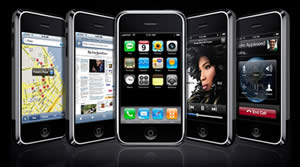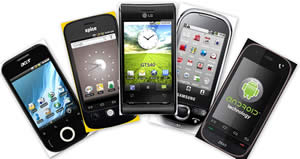Difference between iPhone and Android
Key Difference: iPhone is the flagship phone developed and manufactured solely by Apple. The device operates on Apple’s iOS operating system and is currently in its 5th generation. Android is a popular open-source operating system by Google and is maintained by a consortium of manufacturers and developers. The latest Android available in the market is 4.2.2 Jelly Bean.
 The iPhone vs. Android battle has been going on since the two started batting heads trying to capture each other market share. This is most commonly a biased argument with no clear winner as much of the debate depends on the needs of the user. Many users claim that iPhone is the best phone available out there, while others are avid Android phones. Trying to compare between the two is like trying to compare an apple to a kiwi, while they are both fruits, they are really different from each other. iPhone is the flagship phone by Apple Company, while Android is an operating system by Google.
The iPhone vs. Android battle has been going on since the two started batting heads trying to capture each other market share. This is most commonly a biased argument with no clear winner as much of the debate depends on the needs of the user. Many users claim that iPhone is the best phone available out there, while others are avid Android phones. Trying to compare between the two is like trying to compare an apple to a kiwi, while they are both fruits, they are really different from each other. iPhone is the flagship phone by Apple Company, while Android is an operating system by Google.
iPhone is the flagship phone developed and manufactured solely by Apple. The device operates on Apple’s iOS operating system and is currently in its 5th generation. The latest phone was the Apple iPhone 5, launched on September 21, 2012. The first generation or the original iPhone was announced by the company in June 2007. The iPhone became an instant success with many techies as it was technologically advanced as well as aesthetically appealing. The idea of a multi-touch screen that allowed users to directly input data on to the screen, thus eliminating the need for mouse, keyboard or keys, was conceived by then Apple CEO, Steve Jobs. He revolutionized the phone. Another new feature that was introduced by the phone was the Apple Store, an online application distribution platform that allows users to directly purchase and download applications on to the phone.
 Android is a popular open-source operating system by Google and is maintained by a consortium of manufacturers and developers. It is a Linux-based operating system that was initially designed for touch-screen compatible smartphones and tablet computers. The OS was originally developed by Android Inc. and was later purchased by Google. Primarily, Google only maintained and provided the OS to other cell phone manufacturers. However, the company later started collaborating with other companies to create and cell smartphones. The company recently launched its latest Nexus 4 in collaboration with LG. The company has also tied up with Samsung and HTC for other Nexus devices. Android has gained market share by offering customization capability, more Apps, frequent updates and also being available on various different devices. Google also has an application distribution platform that has a range of different apps from various developers, dubbed Google Play, originally named Android Market. The latest Android available in the market is 4.2.2 Jelly Bean.
Android is a popular open-source operating system by Google and is maintained by a consortium of manufacturers and developers. It is a Linux-based operating system that was initially designed for touch-screen compatible smartphones and tablet computers. The OS was originally developed by Android Inc. and was later purchased by Google. Primarily, Google only maintained and provided the OS to other cell phone manufacturers. However, the company later started collaborating with other companies to create and cell smartphones. The company recently launched its latest Nexus 4 in collaboration with LG. The company has also tied up with Samsung and HTC for other Nexus devices. Android has gained market share by offering customization capability, more Apps, frequent updates and also being available on various different devices. Google also has an application distribution platform that has a range of different apps from various developers, dubbed Google Play, originally named Android Market. The latest Android available in the market is 4.2.2 Jelly Bean.
iPhone and Android have a variety of similar features as well as various different ones. These both differ from each other in terms of availability, customization capability, user control, security, etc. These various features make each device standout. While Android is praised for its ability to offer an operating system that is free, can be easily modified and faster upgrades. The company does fail short in some places such as lack of security and offering less useful apps compared to the ones available in the Apple Store. The iPhones have been praised for their looks, design, performance and their tight security; however, they lack customization ability, they are strict in terms of guidelines, they are quite expensive and even if damaged, repair is quite costly. Both of these phones have their goods points and bad points and each person should choose the phone that is best for them. At this point, both companies are neck-to-neck for the market share and there is no company that is the best.
|
|
iPhone |
Android |
|
Developer |
Apple |
|
|
Operating system |
iOS |
Android |
|
Storage Capacity |
8,16,32, 64 GB |
2,4,8,16,32,64 GB |
|
Features |
3G, 4G capabilities, FaceTime, GPS, turn-by-turn navigation, iTunes support, internet connectivity, virtual keyboard, e-mail, Microsoft Active Sync, large text, VoiceOver, Siri, dual-camera, LED Flash, etc. |
Multi-touch, multi-tasking, Bluetooth, video-calling, java support, flash support, Google Apps integration, NFC, Wi-Fi hotspot, USB-on-the-Go, IR Blaster, additional hardware support, Google Now, Tethering, external storage, media support, third-party software and apps. |
|
Customization |
Apple allows limited customization capability for users. |
Android has high customization capability and allows users to change/alter screen or the OS itself. |
|
Accessibility |
Apple does not allow any modification to its phones. The company offers large text for impaired users. The phone can accommodate closed captioning, external TTY devices, white on black mode and VoiceOver. |
Allows altering the OS itself. It also includes built-in speech text and is also compatible with third party disability software. The phones also support enhancements for people with hearing disabilities. |
|
Source model |
Closed-source, only allows Apple to provides updates or sell the particular software. |
Open-source, anyone can alter, change or upgrade the software and distribute it. |
|
Applications |
Only apple created or approved applications. High number of paid apps and less number of free apps. |
Applications can be created by any developer and offered on Google Play. High number of free applications compared to paid ones. |
|
Application distribution platform |
Apple Store |
Google Play |
|
Number of Apps |
High number of apps found in the App Store. Exceeds 700,000. |
The number of apps is less compared to apps in the Apple Store. However, the number of apps is constantly increasing. |
|
Update Frequency |
Since, updates are only available by Apple. The number of updates is quite less. |
Since the open consortium is responsible for the updates, there are faster and more frequent updates. |
|
Battery |
Non-removable battery |
Many phone manufacturers offer device with removable batteries. |
|
Battery Power |
iPhones provide excellent battery capacity that lasts one day minimum on a full charge. |
Battery power varies depending on the company that manufacturers the phone. |
|
Price |
Apple is more expensive in terms of purchasing the phone, apps, maintenance, repairs, etc. |
Android phones come in a range of prices from low-range to high-range. These phones are also quite cheap to operate and maintain. |
|
Widgets |
iPhones do not offer widgets. |
Android phones offer widgets that allow easier access to settings. |
|
Screen Size |
iPhones have limited screen size which ranges from 3-4 inches. |
Android phones have a variety of different display sizes ranging from 2.5-7 inches. |
|
Third-party software and applications |
Apple does not allow third-party software or applications to run on its device. |
Third-party software or applications are allowed on Android based phones. |
|
Display |
Apple offers high-resolution displays with the recent phones offering Retina display. |
Display is not always consistent on Android phones and depends on the manufacturer the kind of display they want to employ. |
|
Interface |
Apple interface is easier to use, but has minimal customization. Hence a person would have to stick to the all the apps are that already offered by the company. |
Android is a bit difficult to learn for the non-tech savvy. However, once it is understood the system is quite easy and being able to customize helps. |
|
Connectivity |
iPhones have limited connectivity and are little complicated. iPhones also require using iTunes for connecting or modifying anything on the phone. |
Androids are much easier and work by simply connecting the phone to the PC system and adding, removing, modifying files just like you would on a simple computer. Android phones also allow root folders or file mangers that allow easier access to all files on the system. |
|
Data Transfer |
Data transfer also requires using iTunes. |
Data transfer can be done by copy, pasting files from one folder to another. |
|
Home Screen Pages |
iPhone provides with three homescreen pages that allows users to place shortcuts on the screen. |
Most android phones provide up to 7 home screen pages that allows shortcuts and widgets. |
|
Phone Options |
Phone option is limited to the various different generation models offered by Apple. |
Phone options are unlimited, with many companies opting for offering Android on their phones. |
|
Carrier Options |
iPhones are currently limited to being provided by AT&T, Verizon or purchasing an unlocked version from the company itself. |
Android phones are not limited to any carriers and can be purchased with the carriers teamed up with the phone manufacturing company. |
|
Security |
iPhones offer high security as the phones only allow access to applications that are approved by the company. |
Android phones are modified by each manufacturer and this has created many loop holes in security. There are also various third-party applications that are not screened and can easily access the phones when downloaded. |
Image Courtesy: zavamedia.com, india.blog.nimbuzz.com









Add new comment